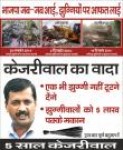A budget campaign
How indispensable are professional PR and advertising agencies to a political party at election time?
If you happen to be the AAP, they are quite dispensable, says SEVANTI NINAN

It was not just the Bharatiya Janata Party (BJP) and the Congress which got a drubbing in the Delhi elections. It was also the notion that a hefty advertising budget and clever public relations agencies can help deliver the vote. The most impressive winning margin seen in recent times was delivered with little reliance on either. Even though we woke up every morning in the final week before polling to see Mr Modi staring out at us from every major newspaper in the city, the seats were won by the party which did no print advertising at all, except in some local neighbourhood pullouts of the Hindi press.
How indispensable are professional PR and advertising agencies to a political party at election time? If you happen to be the AAP, they are quite dispensable, thank you.The BJP was reported to have roped in Madison Media and Soho Square for its campaigns. AAP turned to its volunteers, drawn not just from varied professions, but also from all over the country. Both in 2013 and 2015 it relied heavily on FM radio and produced the jingles and spots in-house.
“Paanch saal, Kejriwal” (five years, Kejriwal) was a line thrown up by one of AAP’s district heads for the elections this year in the course of a brainstorming. As for the spot ads, the party drew on issues identified during its‘Delhi dialogues’ with voters for ideas, and relied upon its volunteers to provide the scripts and voices. To further demonstratethe relianceon in-house can-do, they told reporters that some of theradio ads were recorded on their workers’ mobile phones!
The fact that advertising seems to work in some elections but not in others suggests that it works when things are going well for the party on the ground and the electorate is receptive. In 2004 the ‘India Shining’ campaign did not deliver for the BJP, in 2014 ‘Ab ki baar Modi sarkar’ did. In 2015 again in Delhi, a barrage of full page print ads in the last two days of the campaign did not help the party. In the final week a colleague and I counted 121 ads inserted by the BJP in eight English and Hindi newspapers. For the Congress the tally was 11 adverts over the same period, and for AAP it was zero. Print is by far the most expensive advertising medium, so they chose to do without it.
What did AAP mobilise that gave it the edge? Social media ofcourse, but also warm bodies on the ground. How else do you reach those who live beneath the radar of social media? The reporting on this election suggests a deployment of one lakh volunteers under 14 district committee heads, to hand out handbills house to house and put up posters. And to organize jansabhas where ArvindKejriwal would be the star attraction. Low income voters in the city’s outlying areas were not only reached in this fashion, the party manifesto also took care to spell out point by point what it would aim to do, for instance, for the around 15 lakh residents of 45 resettlement colonies in Delhi.
The AAP got started early, with the campaign properly under way by November. Nobody here was waiting for polling dates to be announced. Radio spots were booked early too. Radio was in fact the key medium in this election—all three parties used the large number of FM channels available. Not just for ad spots but also for interactions through phone-ins.They also came up with their own web radio, "Mango! Aam Aadmi ka Radio!" And the Times of India reported that IIT Bombay volunteers created a research tool in November last year with the specific purpose of trawling social media posts to measure public opinion, to help shape the AAP's election strategy for this assembly election. The BJP had similar multi-faceted volunteer zeal going for it in the 2014 Lok Sabha polls, but not this time around.
When you don’t have deep pockets to buy advertising it helps to have the media on your side. In 2013 Arvind Kejriwal and AAP had all those news channels eating out of their hands. In 2015 their spokespersons were part of studio debates every night, but the work they did on the ground was much less covered. Is that why the media did not sense the scale of the party’s comeback?As RajdeepSardesai pointed out in his blog, there was little TV coverage of AAP’s Delhi dialogues, nor were channels raring to cover Kejriwal’s campaign speeches live as they did with Modi’s Delhi rallies.
And finally, the folks at the AAP had the chutzpah to spoof the face of the party. The 'Muflerman (sic) returns' posters created a Batman-like character out of Arvind Kejriwal, armed with a broom, calling him The Corruption Hunter. They may have got the spelling wrong but the character got considerable traction on social media. Would an ad agency have thought of that?
(This column appeared in Mint on February 19, 2015.)
Subscribe To The Newsletter






